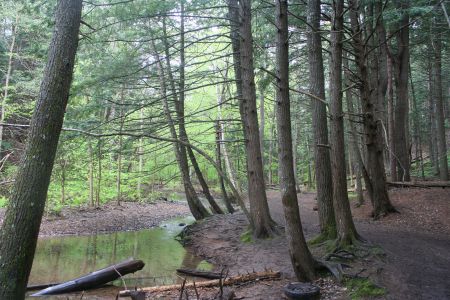K'JIPUKTUK, HALIFAX - At one time, before white settlers arrived, majestic old-growth forests covered most of Nova Scotia. Now all that's left are a few remnants, scattered throughout New Brunswick, PEI and Nova Scotia.
A couple of weeks ago I spent a lovely afternoon among trees that seem to rise up forever, in one such old-growth pocket, this one surprisingly close to downtown Kentville.
I learned about that particular spot through a new book, Journeys Through Eastern Old-Growth Forests, a narrative guide. The book describes 16 of the remaining areas of old-growth that are still around, in New Brunswick, PEI and Nova Scotia.
Author Jamie Simpson, a biologist, arborist, recent law-school graduate, and long-time vocal opponent of current commercial forestry practices wrote the book because he wanted to add a new dimension to our understanding of East Coast woodlands.
"I spent a lot of time being very critical of clearcutting. I'd take my friends to clearcuts, I'd even take my dates there," Simpson told the Halifax Media Co-op. "Then I realized that it is just as important to celebrate these remnants of old-growth forests here in the Maritimes, the beautiful forests that we still have left."
"I think we don't realize entirely what we have done to our forests until we go out and see what it was like, and what it could be again," he says.
For the book Simpson visits each spot, some just an easy stroll from a parking lot, others requiring overnight canoe trips and long bushwhack hikes into the wilds.
As he travels through these woods, sometimes alone, sometimes with companions, we read about what catches his eye, whether that is a salamander, a decaying tree, a hermit thrush or a tiny seedling.
And as we follow Simpson on his journeys we begin to appreciate the complexity and diversity of the original East Coast forest ecology. Much more healthy ecosystems than we encounter in most Nova Scotia forests these days, Simpson argues.
Old-forest species like hemlock, cedar, large white pine and yellow birch were common in the pre-settler days, but have now mostly disappeared. Forest researchers describe old forests as reservoirs of genetic diversity, Simpson writes. And these old-growth forests were vast and covered most of the Maritimes.
There are many reasons why such diversity is a good thing. Simpson mentions tourism, the mental benefits of a walk through these pristine woods, their crucial importance for wildlife and for ongoing employment for forestry workers.
And most importantly, says Simpson, because old-growth forests with all their diversity can act as a buffer against the effects of climate change.
"We have no idea what all the consequences of climate change will be because there are so many variables and uncertainties involved," says Simpson.
"So our insurance policy is to maintain all that health and diversity in these forests so that they can respond and adapt to these changing circumstances. Everything flows from ecological health."
"The forest provides not just wildlife habitat, but clean air, clean water, erosion control, all those services that benefit our communities. Unfortunately we are sort of trashing all these benefits for shortsighted goals," says Simpson.
Which brings us to a second theme in the book. The book is not just about old-growth forests. It's also about provincial regulators at the Department of Natural Resources who far too often allow commercial forestry companies to devastate Nova Scotia's forests.
Simpson and others opened people's eyes when in 2010 they put up billboards in Halifax with aerial photographs of a clearcut in Nova Scotia, 1700 acres of devastation. Mainstream media picked up on the story, people started writing angry letters to their MLAs, rallies were held.
But at the Department of Natural Resources nothing changed.
"As far as I could tell the [NDP] government changed the definition of a clearcut only to ensure that their promise of less clearcutting could easily be met," writes Simpson.
As a result, removing an entire forest canopy but leaving behind a certain amount of seedlings is now called a restorative cut, rather than the clearcut it really is, he argues.
Similarly, leaving a couple of scattered mature trees turns a clearcut into a partial harvest, thanks to the magic of semantics .
Whole tree harvesting is another such shortsighted practice. Removing entire trees rather than leaving stumps and branches behind is detrimental to the forest's ability to recover, Simpson believes. Yet this is what often happens, be it for biomass or to supply the pulp and paper companies.
"Nothing has improved, nothing has changed," Simpson tells the Halifax Media Co-op when asked if the Liberal government is a change for the better. "Clearcutting and whole tree harvesting are still just as rampant, unfortunately we have not seen any improvements."
"It is disheartening that the bad practices that are occurring right now will have an impact on Nova Scotia for decades and centuries to come through the loss of soil fertility, loss of habitat," says Simpson.
"It's ironic because governments want to create jobs and economic growth, and yet they are allowing these practices, just so that in the short term they can put a bit of wood and fiber into the pulp mills and biomass plants," Simpson says.
If not bureaucrats, Simpson hopes that his book will inspire private woodlot owners to manage their woods in such a way that in the future old-growth will once again become the dominant type of forest in Nova Scotia. Private land owners own more than half of wood lands in Nova Scotia.
"Many care very much about their forest, and that's where we see the best land stewardship in the province right now," says Simpson, " whether they are cutting their forests or just letting it be."
Journeys Through Eastern Old-Growth Forests, a narrative guide, by Jamie Simpson, is published by Nimbus Publishing. Includes maps and photos. It's available in local independent bookstores and through the Halifax Public Library system.
See also:
Draft plan shows sensitive forests in Western Nova Scotia open for harvesting
When is a clear cut not a clear cut?
Greenwashing away Nova Scotia's forests
Follow Robert Devet on Twitter @DevetRobert




